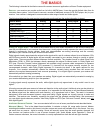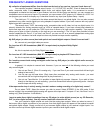12
MAKING THE CONNECTION
It’s tempting to just plug in your new A/V receiver and have great sound pour out. Before you do that, take a few
minutes to plan out how you want the receiver to fit into your audio/video system. Ask yourself the following
questions:
What source components do I want to connect to my receiver? (CD, VCR, etc.)
What equipment will be receiving the audio and video? (TV monitor, Speakers, etc.)
The answers to your questions determine how many cables you need to connect to the back of the receiver.
Good preplanning equals great sound. Keep these recommendations in mind:
List all components in your system and indicate which jacks of the receiver each component will be connected
to. Your receiver has seven sets of inputs. It is convenient to connect a DVD player to the input labeled DVD
or a VCR to the input labeled V1 or TAPE, etc. However, your equipment may differ from the labeling on the
back of your receiver. In most cases you can connect any type of source to any input (see FREQUENTLY
ASKED QUESTIONS). For example, if you don’t have a satellite receiver you can connect a DAT player or a
second cassette deck to SAT. You can also reprogram the source name that will appear on your receiver’s
front panel and on-screen display (see SYSTEM SETUP - INPUTS)
Also note the length of the cable for each component’s connection and describe how it should be routed or
draw your routing scheme below your list. You may want to label each cable with a name or number at both
ends. Use high quality connections to maintain high quality audio and video.
Think about the type and length of cable you need and obstacles in the cable’s path (doorways, furniture,
walkways, etc.). To decide which ones are right for you talk to your dealer about the various cable products
that are available.
For safety, keep all cables out of high traffic areas (hallways or doorways) and away from equipment that
radiates power, including amplifiers, power cords, heaters, etc.
If you might expand your audio/video system later, keep these ideas in mind as you plan current cable runs.
To provide the best tuner reception, make sure the antenna is at least several feet away from the receiver and
any other equipment that may produce high frequency interference such as Personal computers, CD players,
halogen lamps, etc.
Take a look at the back panel of the receiver. You will notice that the RCA-type audio input and output connectors
are identified by colors, red for right channel and white for left channel audio. Red/White/Grey identifies the
surround outputs. Red/Green/Blue identifies component video input and output connectors. Composite video
input and output connectors are identified by yellow. Coaxial digital inputs are identified by orange.


















